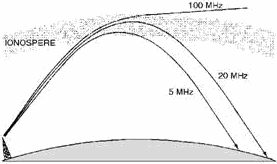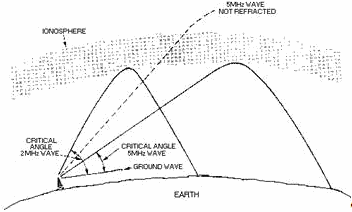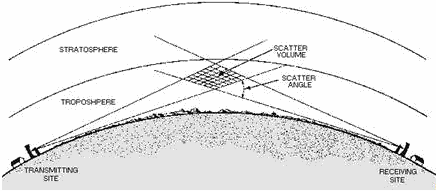Module 10 - Introduction to Wave Propagation, Transmission Lines, and Antennas
Pages i,
1-1,
1-11,
1-21,
1-31,
1-41,
2-1,
2-11,
2-21,
2-31,
2-40,
3-1,
3-11,
3-21,
3-31,
3-41,
3-51,
4-1,
4-11,
4-21,
4-31,
4-41,
4-51, Index
SURFACE WAVES
travel along the contour of the Earth by diffraction.

SPACE WAVES can travel through the air directly to the receiving antenna or can be
reflected from the surface of the Earth.

SKY WAVES, often called ionospheric waves, are radiated in an upward direction and
returned to Earth at some distant location because of refraction. NATURAL HORIZON is the
line-of-sight horizon. Radio HORIZON is one-third farther than the natural horizon.
The IONOSPHERE consists of several layers of ions, formed by the process called ionization.
IONIZATION is the process of knocking electrons free from their parent atom, thus upsetting
electrical neutrality. RECombination is the opposite of ionization; that is, the free
ions combine with positive ions, causing the positive ions to return to their original neutral atom state.
2-41
The D LAYER is the lowest region of the ionosphere and refracts signals of low
frequencies back to Earth. The E LAYER is present during the daylight hours; refracts
signals as high as 20 megahertz back to Earth; and is used for communications up to 1500 miles.
 The F LAYER is divided into the F1 and F2 layers during the day but combine at night to
form one layer. This layer is responsible for high-frequency, long-range transmission. The
CRITICAL Frequency is the maximum frequency that a radio wave can be transmitted vertically and still be
refracted back to Earth.

The CRITICAL ANGLE is the maximum and/or minimum angle that a radio wave can be
transmitted and still be refracted back to Earth.
2-42

SKIP DIsTANCE is the distance between the transmitter and the point where the sky wave
first returns to Earth. SKIP ZONE is the zone of silence between the point where the
ground wave becomes too weak for reception and the point where the sky wave is first returned to Earth.

FADING is caused by variations in signal strength, such as absorption of the RF energy
by the ionosphere.
2-43
MULTIPATH FADING occurs when a transmitted signal divides and takes more than one path to a
receiver and some of the signals arrive out of phase, resulting in a weak or fading signal.

Some Transmission LOSSES that affect radio-wave propagation are ionospheric absorption,
ground reflection, and free-space losses. ELECTROMagnetic INTERFERENCE (EMI), both
natural and man-made, interfere with radio communications. The Maximum USABLE Frequency
(MUF) is the highest frequency that can be used for communications between two locations at a given angle of
incidence and time of day. The LowEST USABLE Frequency (LUF) is the lowest frequency that
can be used for communications between two locations.

2-44
OPTIMUM Working Frequency (FOT) is the most practical operating frequency and the one
that can be relied on to have the fewest problems. PRECIPITATION ATTENUATION can be
caused by rain, fog, snow, and hail; and can affect overall communications considerably.
TEMPERATURE INVERSION causes channels, or ducts, of cool air to form between layers of warm air, which
can cause radio waves to travel far beyond the normal line-of-sight distances.

TROPOSPHERIC PROPAGATION uses the scattering principle to achieve beyond the
line-of-sight radio communications within the troposphere.

2-45
Answers to Questions Q1. Through Q48. A1. Induction field and radiation field. A2. Induction field.
A3. Radiation field. A4. Fundamental frequency. A5. Harmonic frequency or harmonics.
A6. 30 meters. A7. 5 megahertz.
A8. Vertically polarized. A9. Direction of wave propagation. A10. Shifting in the phase
relationships of the wave. A11. Troposphere, stratosphere, and ionosphere.
A12. Stratosphere. A13. Whether the component of the wave is travelling along the surface or over the
surface of the earth. A14. Radio horizon is about 1/3 farther.
A15. Sea water. A16. (a) electrical properties of the terrain (b) frequency (c) polarization of the
antenna A17. High energy ultraviolet light waves from the sun.
A18. D, E, F1, and F2 layers. A19. D layer is 30-55 miles, E layer 55-90 miles, and F layers are
90-240 miles. A20. Thickness of ionized layer. A21. Critical frequency. A22. (a)
density of ionization of the layer (b) frequency (c) angle at which it enters the layer A23. a zone of
silence between the ground wave and sky wave where there is no reception. A24. Where ionization density
is greatest. A25. a term used to describe the multiple pattern a radio wave may follow. A26.
Selective fading.
A27. Natural and man-made interference.
2-46
A28. Natural. A29. Man-made. A30. (a) filtering and shielding of the transmitter
(b) limiting bandwidth (c) cutting the antenna to the correct frequency
A31. (a) physical separation of the antenna (b) limiting bandwidth of the antenna (c) use of directional
antennas A32. Regular and irregular variations. A33. Regular variations can be predicted but
irregular variations are unpredictable. A34. Daily, seasonal, 11-year, and 27-days variation.
A35. Sporadic E, sudden disturbances, and ionospheric storms.
A36. MUF is maximum usable frequency. LUF is lowest usable frequency. FOT is commonly known as optimum working
frequency. A37. MUF is highest around noon. Ultraviolet light waves from the sun are most intense.
A38. When LUF is too low it is absorbed and is too weak for reception.
A39. Signal-to-noise ratio is low and the probability of multipath propagation is greater.
A40. Frequent signal fading and dropouts. A41. FOT is the most practical operating frequency that can
be relied on to avoid problems of multipath, absorbtion, and noise. A42. They can cause attenuation by
scattering. A43. It can cause attenuation by absorbtion.
A44. It is a condition where layers of warm air are formed above layers of cool air. A45. It can cause
VHF and UHF transmission to be propagated far beyond normal line-of-sight distances. A46. Troposphere.
A47. VHF and above. A48. Near the mid-point between the transmitting and receiving antennas, just
above the radio horizon.
2-47
| - |
Matter, Energy,
and Direct Current |
| - |
Alternating Current and Transformers |
| - |
Circuit Protection, Control, and Measurement |
| - |
Electrical Conductors, Wiring Techniques,
and Schematic Reading |
| - |
Generators and Motors |
| - |
Electronic Emission, Tubes, and Power Supplies |
| - |
Solid-State Devices and Power Supplies |
| - |
Amplifiers |
| - |
Wave-Generation and Wave-Shaping Circuits |
| - |
Wave Propagation, Transmission Lines, and
Antennas |
| - |
Microwave Principles |
| - |
Modulation Principles |
| - |
Introduction to Number Systems and Logic Circuits |
| - |
- Introduction to Microelectronics |
| - |
Principles of Synchros, Servos, and Gyros |
| - |
Introduction to Test Equipment |
| - |
Radio-Frequency Communications Principles |
| - |
Radar Principles |
| - |
The Technician's Handbook, Master Glossary |
| - |
Test Methods and Practices |
| - |
Introduction to Digital Computers |
| - |
Magnetic Recording |
| - |
Introduction to Fiber Optics |
| Note: Navy Electricity and Electronics Training
Series (NEETS) content is U.S. Navy property in the public domain. |
|





































